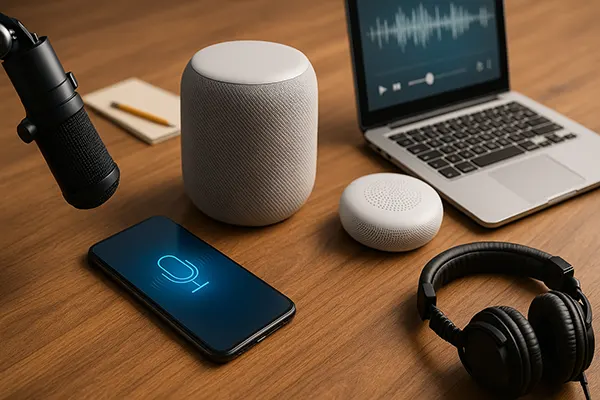
Marketing in Voice and Audio Formats: Podcasts, Navigators, Smart Speakers
Voice and audio marketing has become one of the most dynamic directions in digital communication. With the growth of smart devices, streaming services, and mobile applications, companies are increasingly using voice tools to reach their audiences in more natural and engaging ways. From podcasts to smart speakers, the opportunities for interaction are constantly expanding, and brands need to understand how to use these channels effectively.
Podcasts as a Strategic Marketing Tool
Podcasts have transformed into one of the leading formats for building trust and long-term relationships with audiences. Their popularity in 2025 continues to grow, as listeners appreciate the convenience of consuming content during daily routines such as commuting, exercising, or working at home. Marketers use podcasts not only for brand promotion but also for sharing valuable expertise and knowledge.
Advertising in podcasts has become more targeted thanks to programmatic technologies. Brands can place short sponsorship messages at the beginning or in the middle of episodes, choosing topics that best align with their values. This makes the advertising look natural and less intrusive compared to traditional formats.
Podcasts are also highly effective for niche marketing. By focusing on specialised topics, companies can build communities around their products or services. This approach allows for deeper engagement with audiences who already have a genuine interest in the subject.
Integration of Podcasts into Multichannel Strategies
Today, podcasts are not just standalone content but part of larger ecosystems. Businesses integrate them into broader marketing strategies, combining with social media campaigns, newsletters, and video marketing. This synergy ensures a more consistent and recognisable brand presence across multiple touchpoints.
Podcasts also help in developing personal brands. Experts and business leaders use them to share opinions, interviews, and insights. This strengthens reputation and increases trust, especially in fields where credibility is critical, such as finance, healthcare, or technology.
In 2025, podcasts are increasingly used in B2B marketing. Companies produce series dedicated to industry trends, case studies, and innovations, aiming to strengthen relationships with partners and clients while demonstrating thought leadership.
Voice Assistants and Navigation Services
Voice assistants, embedded into smartphones, cars, and household devices, are revolutionising how people search for information and interact with brands. Users prefer quick and convenient answers through voice queries, which requires businesses to optimise their content for voice search.
For example, when using navigation apps, consumers often look for nearby restaurants, shops, or services. Companies that adapt their local SEO and ensure accurate data in online directories benefit the most, as their business becomes more accessible through simple voice commands.
Navigation services also open new possibilities for contextual advertising. Brands can reach customers during the decision-making process, offering relevant promotions depending on location and time. This increases the effectiveness of campaigns and enhances customer experience.
Personalisation Through Voice Interfaces
Artificial intelligence allows voice assistants to analyse user behaviour and personalise responses. This includes remembering purchase history, preferences, and even voice tones. As a result, brands can provide more individualised offers that meet the specific needs of each customer.
In transport and tourism, voice interfaces are particularly important. They simplify navigation, booking, and service use, which improves customer satisfaction and loyalty. This becomes a competitive advantage in industries with high user expectations.
For marketing specialists, personalisation means opportunities to create more engaging interactions. Voice assistants can recommend products, remind about discounts, or provide service updates in real time, which enhances customer retention.

Smart Speakers as a Marketing Channel
Smart speakers such as Amazon Echo, Google Nest, and Apple HomePod are becoming part of everyday life for millions of people worldwide. They change how consumers consume content and interact with brands. In 2025, the use of smart speakers is no longer limited to simple commands – they serve as centres of home ecosystems.
Brands are investing in the creation of voice applications, also known as “skills” or “actions”, which allow users to order products, listen to branded content, or receive personalised advice. This format creates new interaction points and strengthens customer loyalty.
Smart speakers also provide valuable analytical data. Marketers can track user activity, measure interest in certain content, and adapt their strategies accordingly. This helps in developing more precise and efficient campaigns.
Challenges and Future Prospects
Despite the significant opportunities, voice marketing also faces challenges. Privacy and data protection remain key issues, as users expect transparency in how their information is collected and used. Brands must ensure compliance with regulations such as GDPR to maintain trust.
Another challenge is the technological limitation of voice recognition in different languages and accents. Although accuracy has improved significantly, companies must consider localisation when creating voice content. Ignoring this aspect may reduce the effectiveness of campaigns.
In the future, voice and audio marketing will likely integrate even deeper with artificial intelligence and augmented reality. Voice will become a key element of omnichannel strategies, making interactions between brands and customers more seamless and natural.
